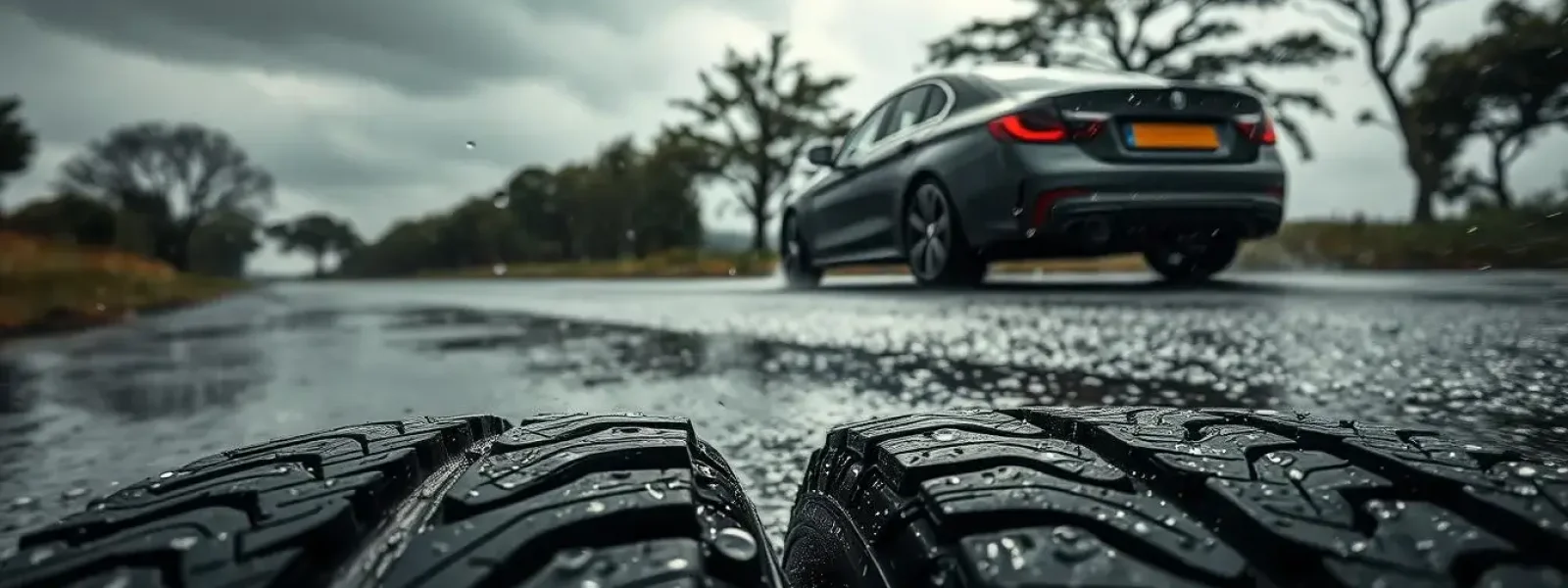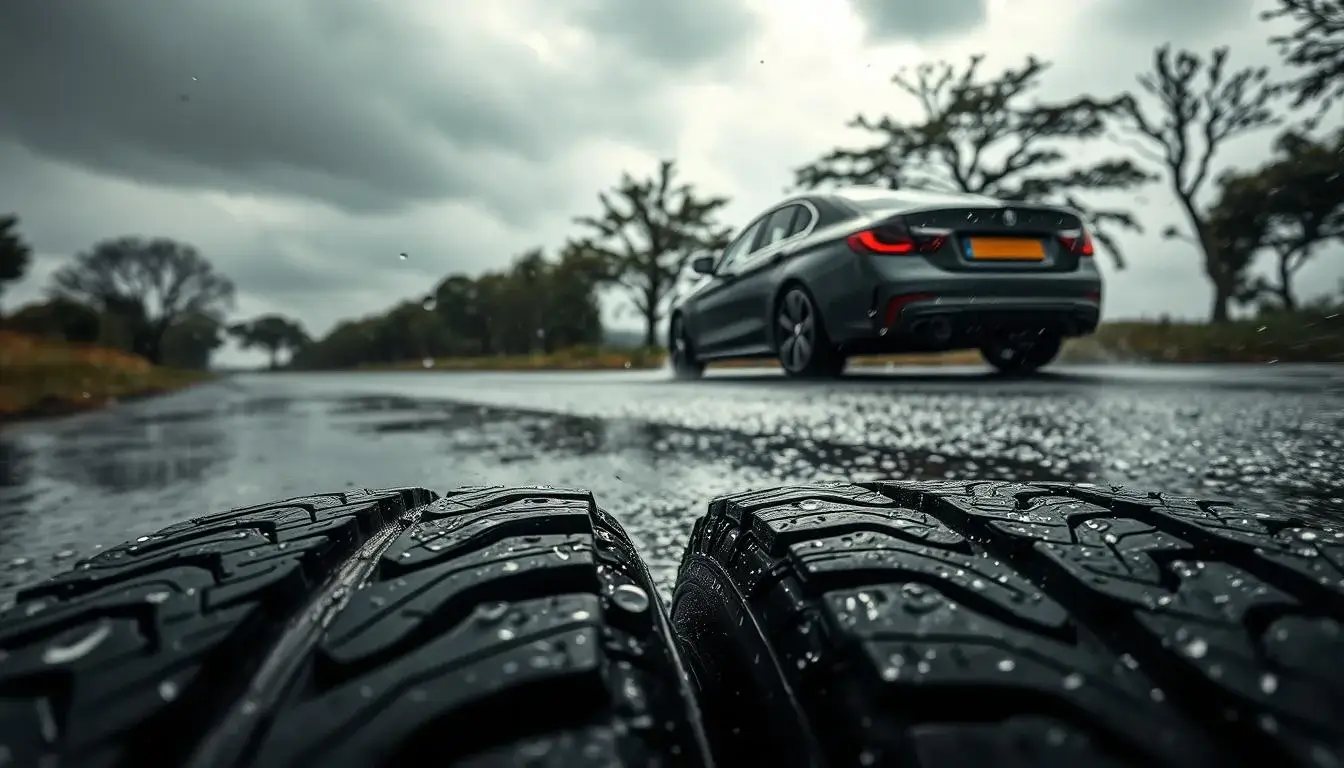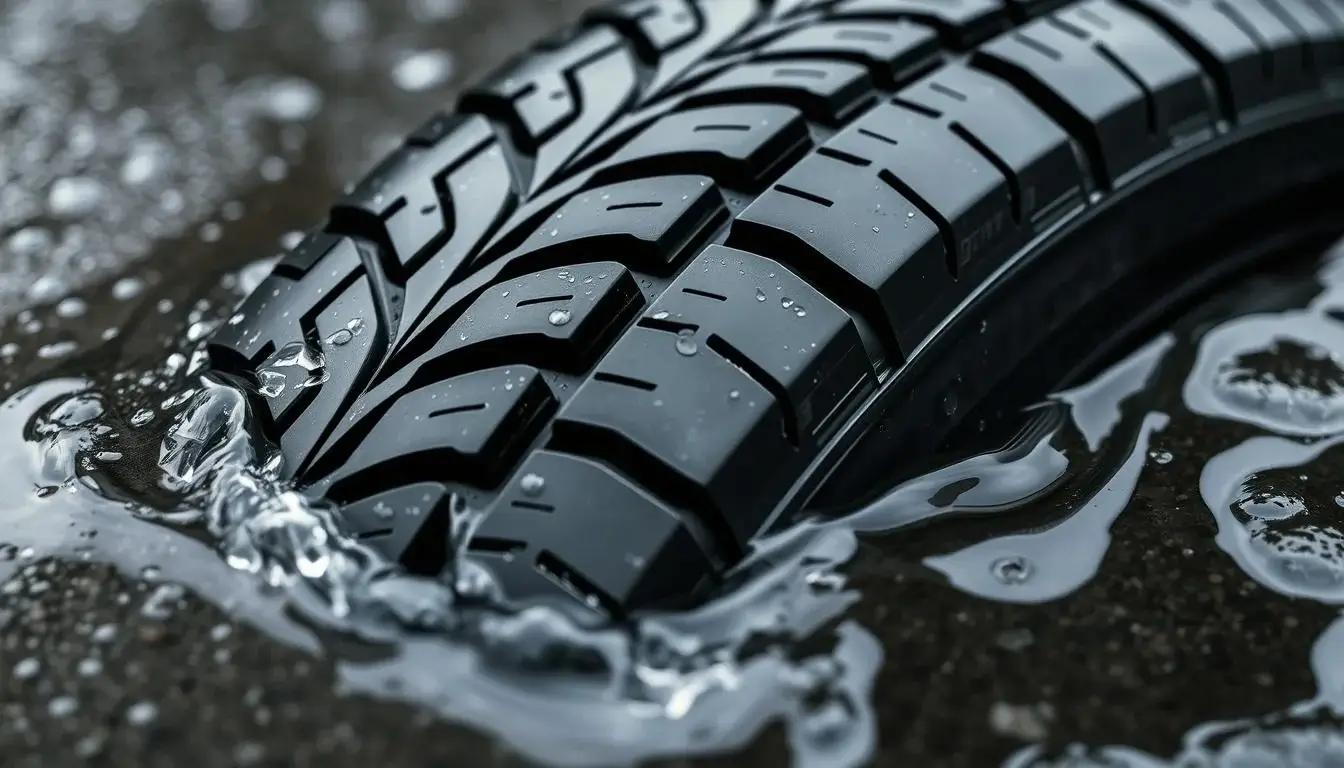When it comes to driving in wet weather, many of us wonder: are summer tires safe in the rain? The answer might surprise you. As the saying goes, “The road to success is always under construction,” and understanding your tires’ performance is no exception. While summer tires are known for their exceptional grip on dry roads, their wet-weather capabilities are often misunderstood.
Contrary to popular belief, summer tires can perform well in the rain, especially within their temperature range. Tests have shown that summer tires can outperform all-season tires in wet conditions, with some models achieving a 10% reduction in stopping distances. However, it’s important to remember that no tire is perfect for every condition. The tradeoff between dry, wet, and snow traction is a delicate balance, as highlighted in the 2011 tire tests.
Let’s dive into the facts and expert insights to separate myth from reality. We’ll explore how summer tires stack up against all-season tires, the role of temperature, and why understanding these differences is crucial for both safety and performance. Whether you’re a seasoned driver or just starting out, this guide will help you make informed decisions about your tires.
Key Takeaways
- Summer tires can provide excellent wet-weather performance within their optimal temperature range.
- They often outperform all-season tires in wet conditions, with improved stopping distances and cornering stability.
- Temperature plays a critical role in tire performance, with summer tires excelling above 45°F (7°C).
- Understanding the tradeoffs between dry, wet, and snow traction is key to choosing the right tire for your needs.
- While summer tires are effective in the rain, they may not be the best choice for snowy or icy conditions.
Understanding the Basics of Summer Tire Performance
When considering how your car handles wet roads, it’s essential to understand what makes summer tires tick. Designed for warmth and moisture, these tires are built to maximize grip and handling in both dry and wet conditions.
The Role of Tread Design and Temperature
The tread pattern on summer tires is specifically crafted to channel water away, reducing hydroplaning risks. This design, combined with a unique rubber compound, ensures optimal performance in warmer temperatures. As temperatures rise, the tire’s rubber becomes more flexible, enhancing grip on both dry and wet surfaces.
| Feature | Summer Tires | All-Season Tires |
|---|---|---|
| Tread Design | Optimized for water dispersion | General purpose tread |
| Temperature Range | Excels above 45°F (7°C) | Works in a broader range |
| Wet Traction | Superior grip and stability | Good but not specialized |
Key Factors Affecting Wet Traction
Beyond tread and temperature, factors like tread depth and road conditions play a role. Deeper treads improve water dispersion, while road debris can affect performance. Proper tire maintenance, such as regular rotation and inflation, also supports better traction.
Summer Tires Safe in the Rain: The Science Behind Wet Traction
Ever wondered how summer tires manage to grip wet roads so effectively? The science behind their performance reveals some fascinating insights.
The Triangle of Tradeoffs: Dry, Wet, and Snow Traction
Imagine a triangle where dry, wet, and snow traction are at each corner. Emphasizing one area affects the others. Summer tires excel in dry and wet conditions but compromise on snow traction. This balance is crucial for their design.
Technical Advancements in Summer Tires
Modern summer tires boast advanced tread designs and rubber compounds that enhance wet traction. These innovations allow them to maintain grip on wet surfaces without sacrificing dry performance. Studies show they can reduce stopping distances by up to 10% compared to all-season tires, making them a safer choice in the rain.
While they shine in wet conditions, their performance drops in snow. This tradeoff is a design choice, prioritizing the environments they’re intended for. For drivers seeking optimal wet and dry performance, summer tires are a top pick.
Real Test Data: Insights from the 2011 and 2012 Tire Trials
When evaluating tire performance in wet conditions, real-world test data provides invaluable insights. The 2011 and 2012 tire trials offer a detailed look at how summer tires compare to all-season tires.
Performance Metrics from 2011 Testing
The 2011 tests highlighted significant differences in wet performance. The PSS summer tire achieved a lap time of 31.37 seconds, outperforming the AS+ all-season tire, which finished in 32.92 seconds. This difference underscores the superior wet traction of summer tires.
| Year | Tire Model | Wet Lap Time (seconds) |
|---|---|---|
| 2011 | PSS (Summer) | 31.37 |
| 2011 | AS+ (All-Season) | 32.92 |
| 2012 | PSS (Summer) | – |
Handling Slippery Conditions in 2012
In 2012, the tests were conducted on an extremely slippery track. Despite the challenging conditions, the PSS summer tire again outperformed the all-season tires, demonstrating consistent wet-weather capabilities. These results emphasize the reliability of summer tires in various wet conditions.
The consistent performance across both years highlights the effectiveness of summer tires in wet environments. These findings are crucial for drivers seeking optimal performance and safety in rainy conditions.
Expert Perspectives and Personal Experiences on Rainy Conditions
Expert opinions and real-world experiences often highlight the effectiveness of summer tires in rainy conditions. Many drivers and tire enthusiasts have shared their insights, providing a clearer picture of how these tires perform in wet weather.
Insights from Tire Testing and Track Performance
A Philadelphia native, who owns both a G35 coupe and an upcoming 328i Sport, shared his experience. He noticed a significant improvement in grip and control when switching from all-season to summer tires. “The difference was night and day,” he remarked. “I felt more confident driving in the rain, especially on highways.”
Tire testing data supports these personal experiences. The 2011 tire trials demonstrated that summer tires, such as the PSS model, outperformed all-season tires in wet conditions. The PSS achieved a lap time of 31.37 seconds, compared to the AS+ all-season tire’s 32.92 seconds. This 1.55-second difference may seem small, but it can be critical in real-world braking situations.
Temperature plays a crucial role in this performance. Summer tires excel when temperatures are above 45°F (7°C), making them ideal for warmer climates. However, they may not be the best choice for snowy or icy conditions, where winter tires are superior.
These insights highlight the importance of matching your tire choice to the weather. While summer tires are not designed for snow, they offer excellent traction and handling in the rain. If you live in an area with mild winters and hot summers, summer tires could be the perfect fit for your driving needs.
🌧️ Need Reliable Summer Tires for Wet Roads? Get Them Delivered & Installed!
Now that you understand how summer tires perform in the rain, it’s time to upgrade for better traction and safety. Amazon offers top-rated summer tires with great pricing, plus the convenience of professional installation services near you—so you don’t have to worry about finding a service center.
✅ Shop top brands, compare the best deals, and schedule installation—all in one place!
🔗 Shop Summer Tires + Installation on Amazon
Summer vs. All-Season Tires: What Sets Them Apart?
When comparing tire options, understanding the differences between summer and all-season tires is key. Summer tires are designed for warmth and moisture, offering superior grip and handling in wet and dry conditions. All-season tires, while versatile, often compromise on wet performance to handle multiple conditions.
Comparative Analysis on Traction and Handling
Summer tires excel in wet conditions due to their tread design, which channels water away, reducing hydroplaning risks. Their rubber compound enhances grip in warmer temperatures. All-season tires, however, prioritize a broader temperature range, sacrificing some wet traction for versatility.
| Feature | Summer Tires | All-Season Tires |
|---|---|---|
| Tread Design | Optimized for water dispersion | General purpose tread |
| Temperature Range | Excels above 45°F (7°C) | Works in a broader range |
| Wet Traction | Superior grip and stability | Good but not specialized |
Test data from 2011 and 2012 shows summer tires like the PSS outperforming all-season tires in wet conditions, with faster lap times and improved stopping distances. This highlights their effectiveness in wet environments.
While all-season tires are versatile, they may not match the wet performance of summer tires. For optimal grip and handling in wet conditions, summer tires are a top choice.
Addressing Common Myths About Summer Tires in Wet Weather
When it comes to understanding how summer tires perform in wet weather, it’s important to separate fact from fiction. One common misconception is that summer tires are designed to handle all conditions, including snow and ice. However, this couldn’t be further from the truth.
Debunking the ‘Snow and Ice’ Misconception
Summer tires are specifically designed for warmer weather and wet conditions, not for snowy or icy environments. Their tread design and rubber compound are optimized for temperatures above 45°F (7°C), making them less effective in colder conditions. While they excel in rain, they are not a substitute for winter tires when snow and ice are present.
Myth vs. Fact: Understanding Tire Design Impact
Let’s clarify some common myths about summer tires:
- Myth: Summer tires are safe in snow and ice.
- Fact: They are not designed for such conditions and may compromise safety.
Expert tests and driver experiences highlight that summer tires perform exceptionally well in wet conditions but should be replaced with winter tires when temperatures drop and snow arrives.
| Feature | Summer Tires | All-Season Tires |
|---|---|---|
| Tread Design | Optimized for water dispersion | General purpose tread |
| Temperature Range | Excels above 45°F (7°C) | Works in a broader range |
| Wet Traction | Superior grip and stability | Good but not specialized |
For optimal safety, switch to winter tires when snow and ice are forecasted. Summer tires are a top choice for wet and dry conditions but not for harsh winter weather.
When to Consider Switching to Alternative Season Tires
Knowing when to switch your tires can make a big difference in your car’s performance and safety. As temperatures drop, it’s essential to consider whether your current tires are up to the task.
Guidelines for Seasonal Tire Management
Summer tires excel in warmer conditions but lose their grip when temperatures fall below 45°F (7°C). At this point, switching to winter or all-season tires becomes crucial. Experts recommend making the switch when snow begins to fall or when temperatures consistently stay below this threshold.
Recognizing Temperature and Weather Cues
Pay attention to the weather forecast and temperature forecasts. If snow is predicted or if the temperature is expected to stay below 45°F for an extended period, it’s time to change your tires. Winter tires are specifically designed to handle icy and snowy conditions, providing better traction and safety.
Using summer tires in inappropriate conditions can lead to reduced performance and safety risks. For example, a study by the Philadelphia Tire Testing Facility found that summer tires performed poorly in snowy conditions, highlighting the importance of switching to winter tires when needed.
Practical advice includes checking your tire pressure regularly, ensuring proper tread depth, and maintaining your tires’ overall condition. For drivers in areas with moderate weather changes, all-weather tires offer a versatile solution, providing good performance in both warm and cold conditions without the need for seasonal switches.
Remember, having a dedicated set of winter tires ensures safety and optimal performance during colder months. Stay proactive with your tire management to enjoy a smooth and safe driving experience all year round.
Tips for Maximizing Your Car’s Safety in the Rain
Maintaining your car’s performance in rainy conditions is crucial for safety and efficiency. By following a few simple tips, you can ensure your vehicle handles well on wet roads.
Routine Maintenance and Tire Care Best Practices
Regular checks are essential to keep your tires in top shape. Start by monitoring tire pressure at least once a month and before long trips. Properly inflated tires improve traction and handling on wet surfaces.
Next, inspect the tread depth. Tires with worn-out treads can hydroplane more easily. If the tread is below 1/16 of an inch, consider replacing them. Also, ensure your tires are clean and free from debris, as dirt can reduce grip on wet roads.
Rotating your tires every 5,000 to 8,000 miles helps maintain even wear and extends their life. This balanced wear improves overall performance and safety in various conditions.
Consult your car’s manufacturer guidelines for specific maintenance schedules. Staying proactive with tire care ensures your car remains safe and reliable in the rain.
🚗 Drive with Confidence – Order Your Summer Tires with Installation Today!
Whether you’re looking for better grip on wet roads, reduced hydroplaning risk, or improved overall performance, the right set of summer tires can make a huge difference. Amazon makes it simple to find the best tires for your vehicle and even helps you schedule professional installation in your area for a hassle-free experience!
☀️ Don’t wait—get your summer tires delivered and installed today!
🔗 Find the Best Summer Tires & Get Them Installed on Amazon
Conclusion
Summer tires are indeed a great choice for driving in the rain, offering excellent grip and control. Studies and expert opinions confirm that they outperform all-season tires in wet conditions, especially when temperatures are warm. However, it’s important to remember that they’re not designed for snowy or icy conditions. If you live in an area with mild winters and hot summers, summer tires could be the perfect fit for your driving needs.
Regular tire maintenance is crucial to ensure optimal performance. This includes checking tire pressure, inspecting tread depth, and rotating your tires every 5,000 to 8,000 miles. Properly maintained tires will improve your car’s safety and efficiency on the road.
For those who experience moderate weather changes, all-weather tires are a versatile option, providing good performance in both warm and cold conditions without the need for seasonal switches. However, if you live in an area with harsh winters, switching to winter tires when temperatures drop below 45°F (7°C) is essential for safety.
In conclusion, understanding your tire options and making informed decisions based on your climate and driving conditions can significantly enhance your driving experience. By choosing the right tires for the season and maintaining them properly, you can ensure a safer and more enjoyable journey.
Thank you for reading! We hope this guide has provided you with valuable insights to make the best choice for your vehicle. Stay informed and keep exploring the world of automotive care!
🚗 Want to know everything about summer tires? From choosing the right set to maximizing performance in warm weather, check out our complete guide to summer tires and make the best decision for your driving needs:
🔗 Everything You Need to Know About Summer Tires: A Powerful & Reliable Summer Tires Guide in 2025
FAQ
Are summer tires safe to use in the rain?
Yes, summer tires are designed to provide excellent grip on wet and dry roads, even during summer months. Their specialized groove patterns and sipes help channel water away, reducing hydroplaning risk. However, their performance may be limited in freezing rain or light snow, so they are not suitable for winter driving.
How do summer tires handle wet traction compared to all-season tires?
In warm weather conditions, high-performance summer tires typically offer superb grip and precise handling on wet and dry roads. However, all-season tires are designed to be more versatile, performing adequately in both summer and winter conditions. If you frequently drive in freezing temperatures, it is advisable to use all-season or winter tires instead.
Can I use summer tires in snowy or freezing conditions?
No, summer tires vs. winter tires differ significantly in performance. Summer tires may be limited in cold weather because their softer rubber hardens in freezing temperatures, reducing traction. If you expect snow or freezing rain, you should get a set of winter tires on your car for improved safety.
What is the difference between summer and winter tires?
There are two types of tires specialized for different conditions:
- Summer tires are engineered for high performance, acceleration, and handling on wet and dry roads in summer months.
- Winter tires have deeper groove patterns, flexible rubber, and additional sipes to maintain grip in snow or freezing conditions.
- Hybrid options, such as all-season tires, offer a balance but may be limited in extreme winter conditions.
How do I maintain my summer tires for better performance in the rain?
Proper maintenance helps maximize the mileage and longevity of your tires:
✅ Check tire pressure regularly – Underinflated tires reduce precise handling and increase wear.
✅ Inspect tread depth – Worn-out tread reduces grip on wet and dry roads.
✅ Rotate your tires – Ensuring even wear extends tire life and savings on replacements.
Can I use summer tires year-round in a warm climate?
Yes! If you live in a region with mild weather conditions, a set of summer tires is ideal for a quiet ride and improved performance. However, if your area experiences freezing rain or sudden temperature drops, consider all-season tires for year-round usability.
Are high-performance summer tires worth the investment?
Absolutely! Performance tires such as Michelin Pilot Sport or Bridgestone Potenza are engineered for superb acceleration, precise handling, and maximum grip. If you enjoy sporty driving, these are the best tires for your vehicle during summer months.
Can I mix summer tires with all-season or winter tires?
No, mixing two types of tires (e.g., summer and winter tires) is unsafe. Doing so can cause uneven wear, unpredictable handling, and reduced safety. For optimal performance, always install a matching set of tires suited for your climate.
What should I do if I hydroplane with summer tires?
If you experience hydroplaning:
🚗 Ease off the accelerator – Avoid sudden movements.
🚗 Keep the wheel steady – Don’t jerk the steering wheel.
🚗 Brake gently if necessary – This helps regain control of your vehicle safely.



